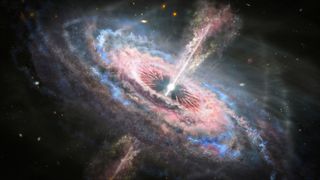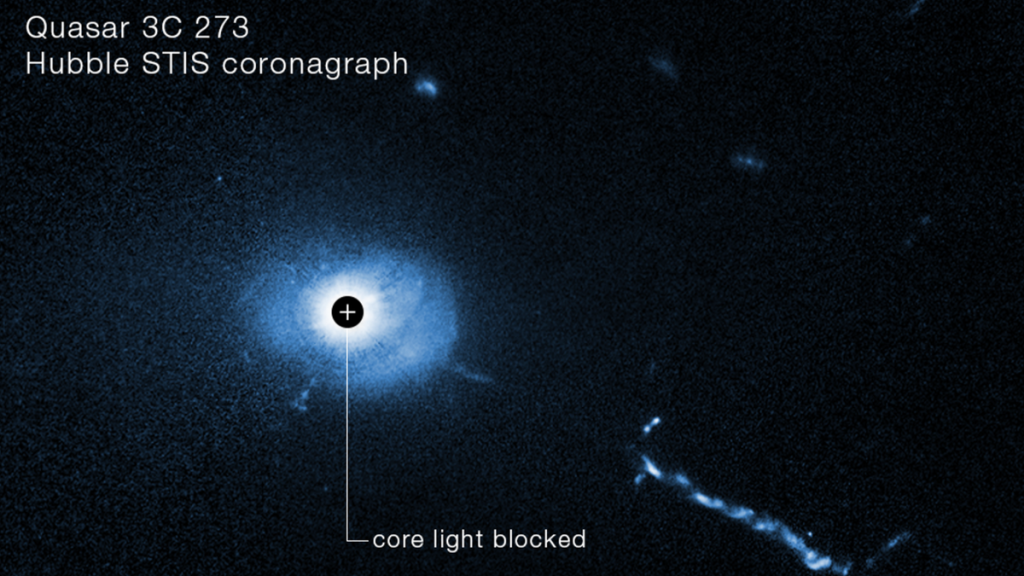The Hubble Space Telescope has stared deeper into a quasar than ever before, discovering “weird” features in its vicinity.
Quasars are the superbright centers of active galaxies, and they’re powered by feeding supermassive black holes. The one Hubble studied, designated 3C 273, is one of the closest of these extreme objects to Earth. 3C 273 is incredibly luminous — so much so that, if it were tens of thousands of light-years from Earth instead of several billion, it would be as bright as the sun in our sky.
That means studying 3C 273 has been like staring into the headlights of an oncoming car for Hubble! However, a new instrument has reduced the glare for the long-serving space telescope, allowing it to get an unprecedented look at the quasar.
Hubble’s imaging spectrograph was the instrument used to dive into 3C 273. This instrument acted like a coronagraph, a cover that astronomers use to block the sun’s photosphere to observe its dimmer outer atmosphere, or corona. This effect is similar to the moon blocking out the sun’s light during a solar eclipse.
Related: What is a quasar?
With the imaging spectrograph blocking out the bright light from the region at the heart of the quasar, Hubble was able to see the structure around the black hole like never before.
Bin Ren of the Côte d’Azur Observatory and Université Côte d’Azur in France explained in a NASA statement that Hubble found lots of “weird things” around the feeding supermassive black hole powering 3C 273.
“We’ve got a few blobs of different sizes and a mysterious L-shaped filamentary structure,” Ren said. “This is all within 16,000 light-years of the black hole.”
Some of these objects could be small galaxies falling toward the black hole, supplying it with food in the form of gas and dust that it uses to power the quasar.
Not all supermassive black holes are hungry
There are around 1 million quasars scattered around the sky over Earth, but these supermassive black hole-powered events were even more abundant around 3 billion years after the Big Bang.
Supermassive black holes with masses equivalent to millions or even billions of suns are thought to sit at the heart of all large galaxies, but not all galaxies host a quasar. That is because not all supermassive black holes are surrounded by a larder of gas, dust and even stars to feed upon.
For instance, Sagittarius A* (Sgr A*) sits at the heart of our galaxy, the Milky Way. Even when seen at a distance, Sgr A* wouldn’t be a quasar, because it’s surrounded by so little matter that if it were a human, it would be on a diet equivalent to one grain of rice every million years!
When supermassive black holes are surrounded by a flattened cloud of gas and dust called an accretion disk, their immense gravity generates tremendous tidal forces in this material. This heats it and causes it to glow brightly.

Additionally, material that isn’t fed to the black hole is channeled to the poles of this cosmic titan by powerful magnetic fields that also accelerate these particles to near the speed of light.
From the poles, this superheated gas or plasma is blasted out as two astrophysical jets that can stretch out for many hundreds of light-years. This is coupled with an energetic emission of light.
That makes these regions, known as active galactic nuclei (AGN), seen as quasars incredibly bright. They are often so bright that they outshine the combined light of every star in the galaxies around them.
The new Hubble observations have granted Ren and colleagues a rare insight into the 300,000-light-year-long jet blasting out of 3C 273 and far beyond the galaxy it sits in.
The team compared the new images of 3C 273 to archival images with a 22-year separation between the two. This led Ren and colleagues to conclude that the jet moves faster when it is farther away from the supermassive black hole at the heart of this quasar.
“Our previous view was very limited, but Hubble is allowing us to understand the complicated quasar morphology and galactic interactions in detail,” Ren concluded “In the future, looking further at 3C 273 in infrared light with the James Webb Space Telescope might give us more clues.”

